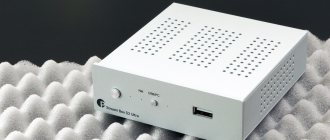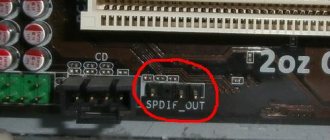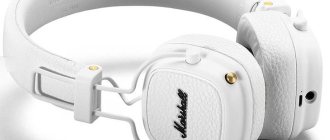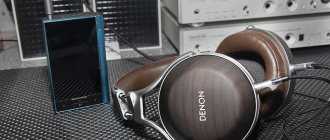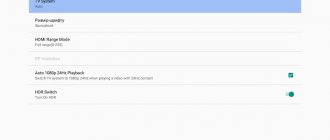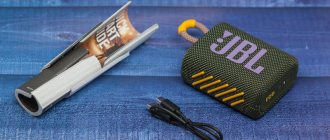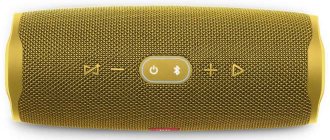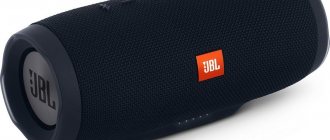The “vinyl renaissance” that we have been observing in recent years does not at all mean that everyone suddenly became fans of the old - well, time-tested - technology, put up with its inconveniences and shortcomings and does not want to hear about digital audio. On the contrary, it is gaining momentum, offering increasingly higher sound quality while further reducing costs and increasing ease of use. It’s no wonder that such a luminary of analog audio as the Pro-Ject company has an extensive family of digital devices in its product range.
Save and read later -
What goes with it?
With a personal computer with a high-quality software player on board, active speakers and/or headphones of a comparable price level.
In the photo this Hi-Fi component looks quite solid, but in reality it easily fits in the palm of your hand, which, however, does not diminish its technical advantages. Available in two finishes: black and silver.
This family includes six lines of electronic components in small and very tiny packages. The Pro-Ject Pre Box S2 Digital DAC belongs to the second category, and the S2 series occupies a middle position in it - there are devices both cheaper and more expensive. It includes two dozen models, from which you can create a versatile, full-fledged Hi-Fi system that can fit on the edge of a table or in a corner of a shelf.
However, you can limit yourself to just one Pre Box S2 Digital in order to listen to music with high quality and pleasure - just get good active speakers and/or headphones, but a personal computer has already become an indispensable attribute of modern life. This device functions as an external USB DAC, preamp, and headphone amplifier. It also has a pair of SPDIF inputs, allowing it to be used with more traditional Hi-Fi digital sources. In this case, a small but convenient remote control would be useful.
This representative of the S2 line is the first to use dual-mono circuitry, based on two high-quality 32-bit digital-to-analog conversion chips ESS Saber ESS9038Q2M. This ensured it compatibility and processing of PCM streams with parameters up to 32 bit/768 kHz and DSD up to DSD512 on the USB input. It also has hardware support for the MQA format.
The company, famous for its vinyl turntables, also boasts its own digital technologies. In particular, in Pre Box S2 Digital, in addition to the seven digital filters “in the package” with the DAC chips, Transient Optimum, developed by Pro-Ject, is used, as well as a proprietary clock generator circuit, which made it possible to achieve such a minimum of jitter that many competitors can envy. “Digital audio is the art of time management,” says the company’s website.
The entire contents of the multifunctional device were able to fit into a tiny case, among other things, thanks to the use of organic polymer capacitors and thin-film mini-resistors on a four-layer printed circuit board with gold-plated tracks.
Which preamplifier is better to buy?
When choosing a device, you should consider the number of input channels. The required value depends on the individual needs of the future owner. For home use, the optimal solution would be to purchase a preamplifier with 2 channels; in a professional studio, 4 or more may be required.
In Hi-Fi and Hi-End audio systems, it is possible to use a preamplifier as a hub for connecting other components.
We should not forget about ease of management. This is especially important when connecting a large number of devices or needing to fine-tune the sound. We recommend purchasing a model equipped with a remote control or that supports a mobile application.
An important characteristic is also the signal-to-noise ratio. A high value will provide a cleaner output sound. For simple home music listening, 75 dB will be enough. High quality audio systems will require a ratio of at least 90 dB.
It is worth paying attention to the frequency range. Most people have a lower threshold of hearing of 16 Hertz and an upper threshold of 20,000. This is the optimal frequency range of the preamplifier. High quality models may have extended limits to improve phase alignment.
Small component of a large Hi-Fi system
The device is powered in two ways: using the included network adapter if the content source is connected via a coaxial or optical input, and if a USB connection to a PC is used, then it will be enough to power the DAC. In this case, it is strongly recommended to disconnect the adapter.
Since the Pro-Ject Pre Box S2 Digital has volume control, it can become a companion to active speakers in a minimalist system. During testing, we tried to check how high-quality a signal it could provide them with, so we connected this DAC to very expensive and serious components, which, of course, are not a match for it, but they certainly won’t spoil anything, but will only fully demonstrate its capabilities. This is a Yamaha C-5000/M-5000 two-component amplifier and Revel F-52 floorstanding speakers. The digital stream initially came to the coaxial input of the DAC from the Technics SL-G700 network player.
The Pre Box S2 Digital DAC managed to show itself in the most worthy way. It has a balanced, detailed, dynamic sound with deep lows and excellent focus. Beethoven's Fifth Symphony, performed by an orchestra conducted by T. Currentzis, is presented in an informative and expressive manner. The stage is large-scale and well-structured; the instruments are not crowded on it. This expressive interpretation of the famous work is full of sudden, large-scale dynamic shifts, and it is important that the flow of the music does not slow down, and that the quiet parts are no less clear than the loudest ones. The Pro-Ject DAC copes well with all this, providing thoughtful and at the same time emotional listening. We can only note that in comparison with more expensive competitors, for example the RME ADI-2 DAC FS DAC, the sound is somewhat lacking in timbral richness and sophistication, and therefore naturalness.
The DAC is made in a double-layer metal case, on the aluminum front panel there is a 6.3 mm headphone output, a volume knob and other controls, as well as a small display. However, some settings are available using the remote control.
The Best Premium Preamps
Such models comply with Hi-Fi requirements and can be included in high-quality audio systems. Premium preamplifiers often have an extended frequency range and are designed to simultaneously connect a large number of devices.
Audio Research LS28
5
★★★★★
editorial assessment
100%
buyers recommend this product
Wide possibilities for switching in this model are provided by a large number of linear and balanced inputs and outputs, support for the RS-232 interface and an external IR sensor. An intuitive menu makes it easy to operate the device even for an untrained owner.
The reproduced frequency range is insanely wide (0.4-200000 Hz), harmonic distortion is 0.007%. The user has access to the functions of phase inversion, renaming inputs, automatic power off, etc. The display shows information about all the necessary parameters of the preamplifier.
Advantages:
- quick setup;
- convenient control;
- high sound quality;
- easy installation;
- multifunctionality.
Flaws:
- high price.
The Audio Research LS28 is compatible with virtually any modern amplifier. An excellent choice for professional use.
PrimaLuna EVO 300 Preamplifier
5
★★★★★
editorial assessment
97%
buyers recommend this product
The features of the preamplifier include increased input impedance and high sensitivity. Both amplification channels are independent of each other, which ensures high-quality stereo sound. To connect external signal sources, there are five standard RCA connectors on the rear panel.
Supported frequency range is 12-75000 Hz, signal-to-noise ratio is 93 dB. To select the input signal, the device uses a sealed relay, which prevents the occurrence of unnecessary noise and interference from third-party sources.
Advantages:
- convenient installation;
- simple controls;
- minimum number of wires;
- high sound quality;
- long service life.
Flaws:
- weight almost 24 kg.
PrimaLuna EVO 300 Preamplifier works great under high load conditions. Suitable for connecting phono stages and DACs.
READ ALSO
12 Best Home Combo Amplifiers
Rotel RC-1590
4.9
★★★★★
editorial assessment
95%
buyers recommend this product
A large number of digital and analog inputs allows the owner to create an extensive audio system. The power supply is equipped with two toroidal transformers. Separate stabilizers are equipped with filters on foil capacitors and are characterized by a low level of distortion.
Frequency range - from 10 Hz to 100 kHz, harmonic distortion does not exceed 0.004%. The presence of a built-in Bluetooth module makes it possible to receive an audio signal from any portable device. Support for RS-232 and Ethernet connectors makes it easy to connect external control systems.
Advantages:
- built-in MM phono stage;
- Bluetooth receiver;
- high sound quality;
- ease of control;
- many entrances.
Flaws:
- sensitivity to interference in the electrical network.
The Rotel RC-1590 is worth purchasing for owners of a large number of devices. A universal solution for both home and professional studio.
Bryston BP-26
4.8
★★★★★
editorial assessment
93%
buyers recommend this product
Full autonomy of the channels ensures reduced noise and interference during preamplifier operation. Using a soft switching circuit avoids current surges and extends the life of the equipment. Multi-colored LED display indicates the current status of the channels.
The reproduced frequency range is within 20-20000 Hz, the intermodulation distortion coefficient is 0.001%. When thermal overload occurs, the preamp automatically turns off to prevent damage. Control is carried out using the remote control.
Advantages:
- external power supply;
- convenient control;
- clear sound;
- status indication;
- fast connection.
Flaws:
- large dimensions.
The Bryston BP-26 is designed to work in a rack somewhere in an amateur studio.
Vincent SA-96
4.8
★★★★★
editorial assessment
90%
buyers recommend this product
A feature of the model should be considered a vertical layout. Small dimensions and a weight of only 3 kilograms make it easy to place the preamplifier in confined spaces. The presence of a built-in MP3 player allows the owner to play audio files directly.
With a standard frequency range of 20-20000 Hz, the signal-to-noise ratio is 90 dB. The LED indication system informs about the activity of connectors, device status, blocking of outputs, etc. A large number of control buttons and support for a remote control simplify setting up and monitoring the operation of the device.
Advantages:
- own MP3 player;
- Headphone Amplifier;
- small dimensions;
- ease of control;
- status indication.
Flaws:
- Difficult navigation in the player.
Vincent SA-96 is designed to work in conjunction with the SP-996 amplifier and is suitable for use in smart home systems.
Target use
A more targeted use of this device - with a personal computer - was implemented using the Intel NUC8I5BEH mini-PC, which has approximately the same dimensions as the DAC from the Pro-Ject S2 line. As a rule, in this case, the choice of software player has a great influence on the sound quality; our content source had perhaps the best to date - Roon. Its Roon Core software is installed on the NUC, and the component we tested is marked Roon Tested in the description.
Muse's songs from the album Black Holes and Revelations, available on Tidal, sound better through the USB input than through the coaxial input of the Technics SL-G700. The scene turns out deeper and more organized with better elaboration of all the details and nuances of multifaceted and effect-rich compositions. Deep, rhythmic bass lines are more clearly controlled and contain more texture. Vocals take their proper place in this musical canvas and appear more alive and expressive. And if you select the same recording in MQA format, the sound quality will receive an additional increase in all aspects. However, the competitor mentioned above from RME also shows more talent when connected via USB.
In the Oppo PM-3 headphones, the sound has a similar character, except that the acoustic space above the head is not large-scale, and the presentation is generally more meager and restrained. However, this method of listening provides a tireless and emotional perception of music of a wide variety of genres. It's also worth experimenting with digital filters - the difference is small, but the shades they add to the sound will allow you to adjust it to your taste.
There was hardly anything else that could fit on the back panel.
Let's sum it up
For its size and price, the Pro-Ject Pre Box S2 Digital DAC is very good. It performs as many functions as its small body allows, and in terms of the list of technical characteristics, in particular the supported sampling parameters and signal formats, it keeps pace with the most advanced competitors. It has quite high-quality sound - balanced, detailed, dynamic - so it will not become a weak link in a system with headphones and/or active speakers of a comparable price level. When using with a PC, you should take care of a decent software player and its optimal configuration.
All equipment was tested in Audiomania showrooms How we test Hi-Fi components
March 2022
This review has been read 7,117 times.

